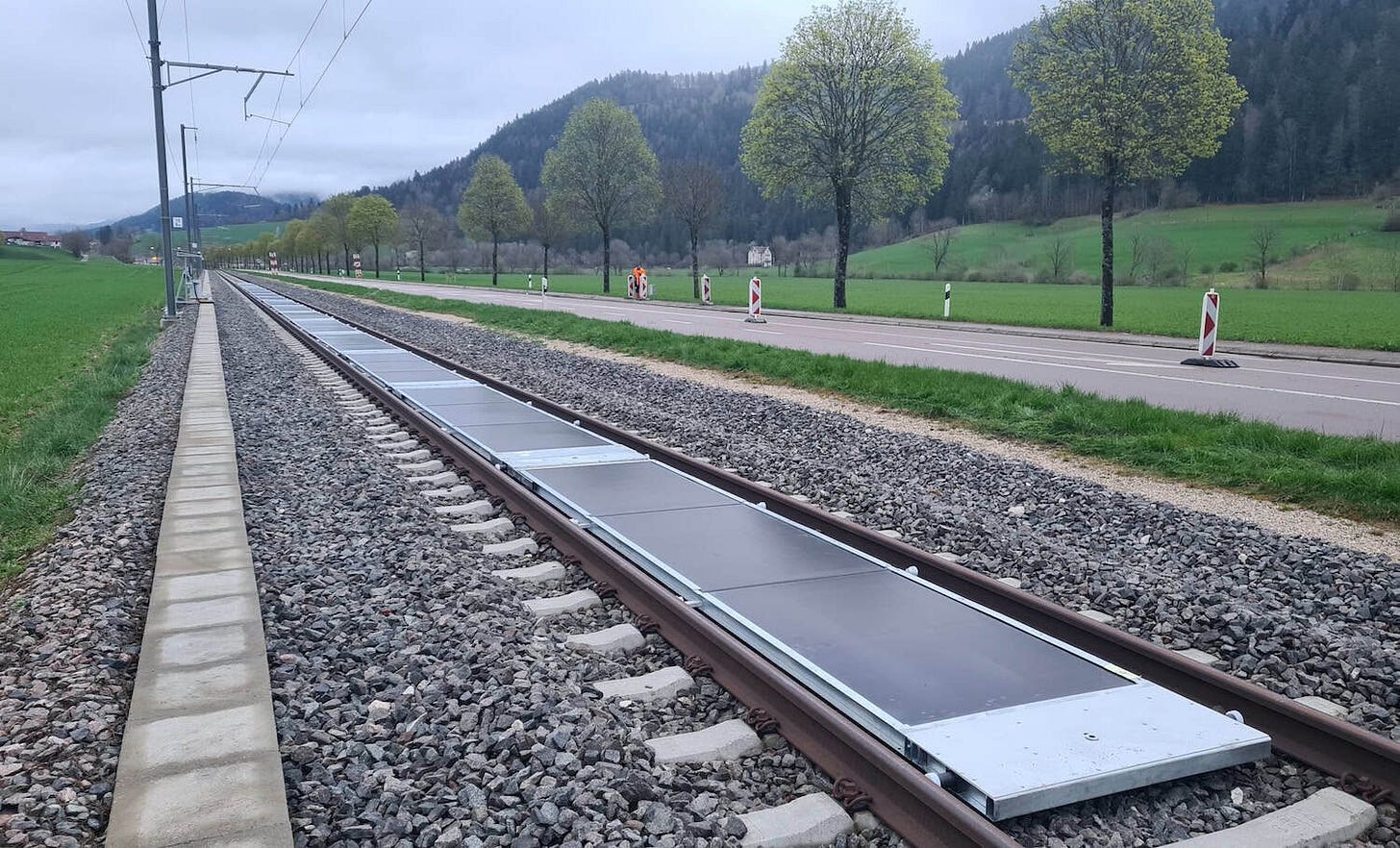Renewable energy is rapidly displacing fossil sources worldwide
Installations of solar panels and wind turbines are scaling up much faster than anticipated, offering some hope of slowing the effects of global warming
In this post:
How solar and wind energy production is ramping up
Greece’s green energy revolution
An innovative solution in Switzerland
Tree canopy cover is increasing in the U.S.
Despite recent sombre news about global warming and the rollback by the Trump administration of Biden-era green energy incentives in the United States, some positive developments on the environmental front: solar and wind energy are now meeting more than 95% of global demand for new electricity. What’s even more encouraging is that the trend towards renewables is accelerating at an impressive pace.
In this post I’ll highlight a handful of interesting developments and ideas for clean energy infrastructure, but these are dwarfed by the overall impact of the revolution currently underway.
The world-changing shift to solar and wind power was summarized recently by Bill McKibben, a contributing writer at the The New Yorker magazine who focuses on climate policy, in an article titled 4.6 Billion Years On, the Sun is Having a Moment.
…with surprisingly little notice, renewable energy has suddenly become the obvious, mainstream, cost-efficient choice around the world.
Spurred by innovations in China and Europe, a lot has happened in the last two years. Solar panels are becoming cheaper, more effective and more in-demand. Wind turbines are collecting energy while we sleep. Large battery farms are storing vast amounts of energy and redistributing it on demand.
The New Yorker article notes that it took 68 years for the world to produce one terawatt of electricity from solar power, from the time the photovoltaic cell was invented in 1954 to 2022. But in the short period from 2022 to 2024 the output of electricity from solar energy jumped to a second terawatt. The third terawatt is expected within a year. That’s an impressive acceleration.
A sense of scale

To understand terawatts, let’s look at some figures:
For scale, think of incandescent light bulbs found in homes. Many are rated at 60 watts.
1,0000 watts make 1 kilowatt.
Going up into ever larger groupings,
1,000 kilowatts comprise 1 megawatt.
1,000 megawatts make up 1 gigawatt.
1,000 gigawatts represent 1 terawatt of electricity.
Just one (1) gigawatt can power more than 800,000 homes for one year. This may help put the even larger number of terawatts into perspective. It’s hard to understand the scale because these words represent a series of exponential zeros that are hard to imagine.
Simply put, electric power production from renewable sources is very big and getting bigger every day.

The New Yorker article explains the rapid increase of solar power this way:
….people are now putting up a gigawatt’s worth of solar panels, the rough equivalent of the power generated by one coal-fired plant, every fifteen hours. Solar power is now growing faster than any power source in history, and it is closely followed by wind power—which is really another form of energy from the sun, since it is differential heating of the earth that produces the wind that turns the turbines.
All this means that countries are becoming less reliant on coal plants, less reliant on natural gas and less reliant on other fossil fuels like oil in general.
And because countries depend ever less on these limited, underground fossil reserves found in select places on the earth, they have been, in a way, freed. Nations now have more access to different forms of renewable energy sources that are found everywhere. This not only slows climate change in a significant way, but potentially also reduces the influence of geopolitics, which for centuries hinged on the relationships between nations with plentiful oil and gas supplies and those coveting those reserves.
The sun and the wind are available everywhere, and they complement each other well; when sunlight diminishes in the northern latitudes at the approach of winter, the winds pick up. This energy is impossible to hoard and difficult to fight wars over. If you’re interested in abundance, the sun beams tens of thousands of times more energy at the earth than we currently need. Paradigm shifts like this don’t come along often: the Industrial Revolution, the computer revolution. But, when they do, they change the world in profound and unpredictable ways.
-Bill McKibben
A global view
If there is a leading adopter of renewable energy, with proportional reductions in harmful greenhouse emissions, it is China. The country is the world’s largest producer of solar power and exports the majority of photovoltaic panels and batteries used in the rest of the world. Last year almost half of the automobiles sold in China were either hybrid or 100% electric vehicles. Prices for Chinese-made electric products are dropping as innovations continue at a rapid pace and as markets get bigger.
While China is leading the world with its sheer scale, other countries are also shifting their infrastructure to renewables. Even in the United States, where conservative policies resist supporting green industries, the role of coal and gas plants is waning: fossil fuels are now generating less than half of the country’s electricity needs. The rest is made up of renewable sources.
Greece is another example. There, solar and wind have taken over from coal in the generation of electricity, as this chart from Our World in Data shows:
And look at the effect on emissions:
Innovation
In Switzerland, meanwhile, entrepreneurs grappling with that country’s scarcity of land and challenging alpine terrain, have developed an interesting solution for the placement of solar panels.
Innovator Joseph Scuderi and his team spotted the possibilities of utilizing railway tracks for this purpose. They developed Sun-Ways, a system of mechanically laying solar panels between the rails. Using a specially-designed railway car, over one-thousand standard-sized solar panels can be laid each day (about 150 panels per hour).
The first section of test track was activated this spring. This experiment is expected to contribute to the long-term growth of renewable energy in the country. Switzerland wants to increase its solar energy output seven-fold in order to meet climate goals.
The railway solution bypasses much of the opposition to solar panel arrays expressed by alpine residents, farmers, municipalities and various other groups.
~~~
Tree cover is increasing in most American communities

In the United States, a study has found that almost 60% of regional districts (counties), have experienced an increase in tree canopies in the first decades of the 21st century. The review, conducted on behalf of LawnStarters, a national landscaping company, analyzed geographical data for the entire nation covering the period from 2000 to 2020.
The study found that prairie and Midwestern states are becoming greener. The areas where canopies increased most noticeably were Lea County, New Mexico, and Yoakum County in Texas. Lea County experienced a dramatic jump in canopy cover of 1,300%, while Yoakum’s increase was 310%. Twenty years ago, both of these areas had small amounts of trees; however, population changes, decreased farming and ranching activities, and the revegetation of abandoned oil wells all contributed to more trees growing.
Leaf cover mitigates global warming by creating a cooling effect, stimulating biodiversity and reducing erosion
It’s an interesting twist that Lea and Yoakum counties and several others listed high in the ranking are also noted for their historic oil production in the large sedimentary area of the Southwest known as the Permian Basin.
The study also found that increases in tree cover were not limited to rural areas. Canopies grew in 14 of the 25 most populated counties in the United States, where shade is yearned for in places dominated by heat-reflecting concrete and asphalt. These areas included Wayne County, Michigan (Detroit area), Kings County, New York (Brooklyn and parts of NYC) and Broward County, Florida (Miami area).
If you’d like to review the full study, it is located here.
~~~
Closing sketch
On the subject of plants, here’s my quick drawing for this week. When I sketched this, I believe I was looking at a kind of Echeveria, a drought-resistant, succulent species. The fleshy leaves store water and are oily to the touch.
Thanks for taking the time to read this week’s post.
-Renato Zane.
~~~
PS. If you’re interested in browsing more articles, the home page is here. Navigate through topics via the tabs at the top.










In a time when we hear so much negative news, this is truly refreshing and uplifting. There is hope. Thanks Renato.
Thanks for a very insightful article. Canada has thousands of kilometres of unused railway track that could be repurposed for solar panel installations, following the Swiss model!